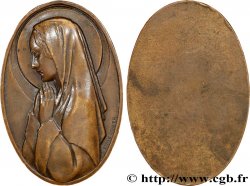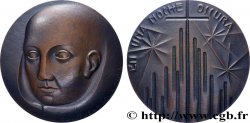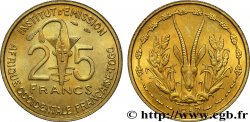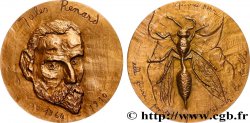fme_987827 - RELIGIOUS MEDALS Médaille, Saint Fiacre
70.00 €(Approx. 81.90$ | 60.90£)
Quantity
Add to your cart

Type : Médaille, Saint Fiacre
Date: n.d.
Mint name / Town : Monnaie de Paris
Metal : bronze
Diameter : 66,5 mm
Orientation dies : 12 h.
Engraver DEVIGNE Jacques (1925-2019)
Weight : 124,15 g.
Edge : lisse + corne BRONZE
Puncheon : corne BRONZE
Coments on the condition:
Patine hétérogène marron claire, usures dans les champs et sur la tranche
Catalogue references :
Obverse
Obverse legend : . SA - INT - FIA - CR - E.
Obverse description : Saint Fiacre en train de défricher des terres, la pelle à la main. A droite, une femme dénudée pointant du doigt, Becnaude, l’accusant de sorcellerie, conformément à la légende. A l’arrière plan, une étoile ou une fleur auréolée et un père abbé portant une crosse. Signé : JAD.
Reverse
Reverse legend : SAINT - FIACRE.
Reverse description : La légende de part et d’autre une crosse et une pelle, avec des frises et des flammes stylisées.
Commentary
Avec sa boite cartonnée ronde bordeaux de la Monnaie de Paris.
Fiacre, né v. 590 dans le Connacht, près de Kilkenny et mort le 30 août vers 670 (ou plutôt en 620 selon Gabriel Buzlin au XVIe), est un moine herboriste et anachorète. Irlandais de noble origine, il fonda près de Meaux un monastère épiscopal, où il est enterré.Saint Fiacre demande des terres pour son monastère et Saint Faron promit de lui concéder autant de terres adjacentes qu'il pourrait défricher en un jour.
Saint Fiacre n'eut aucun mal à dégager une grande surface en l'espace d'une journée, bien des arbres se laissant abattre avec facilité. La réussite de son entreprise continua de plus belle.
La légende veut alors qu'une femme nommée « Becnaude » l'accusa de sorcellerie à l'évêché. Saint Faron alerté, constata ces guérisons et en conclut que Fiacre était un saint. Sa vertu reconnue, saint Fiacre put poursuivre son existence de prière et de charité sous la protection de Notre Dame à laquelle il dédia son monastère qui devint un lieu de pèlerinage réputé. Après sa mort, le monastère prit son nom..
With its round burgundy cardboard box from the Paris Mint. Fiacre, born around 590 in Connacht, near Kilkenny and died on August 30 around 670 (or rather in 620 according to Gabriel Buzlin in the 16th century), was a herbalist and anchorite monk. Irish of noble origin, he founded an episcopal monastery near Meaux, where he is buried. Saint Fiacre requested land for his monastery and Saint Faron promised to grant him as much adjacent land as he could clear in a day. Saint Fiacre had no trouble clearing a large area in the space of a day, as many trees could be felled with ease. The success of his enterprise continued unabated. Legend has it that a woman named \\\"Becnaude\\\" accused him of witchcraft at the bishopric. Saint Faron, alerted, noted these healings and concluded that Fiacre was a saint. His virtue recognized, Saint Fiacre was able to continue his life of prayer and charity under the protection of Our Lady, to whom he dedicated his monastery, which became a renowned place of pilgrimage. After his death, the monastery took his name.
Fiacre, né v. 590 dans le Connacht, près de Kilkenny et mort le 30 août vers 670 (ou plutôt en 620 selon Gabriel Buzlin au XVIe), est un moine herboriste et anachorète. Irlandais de noble origine, il fonda près de Meaux un monastère épiscopal, où il est enterré.Saint Fiacre demande des terres pour son monastère et Saint Faron promit de lui concéder autant de terres adjacentes qu'il pourrait défricher en un jour.
Saint Fiacre n'eut aucun mal à dégager une grande surface en l'espace d'une journée, bien des arbres se laissant abattre avec facilité. La réussite de son entreprise continua de plus belle.
La légende veut alors qu'une femme nommée « Becnaude » l'accusa de sorcellerie à l'évêché. Saint Faron alerté, constata ces guérisons et en conclut que Fiacre était un saint. Sa vertu reconnue, saint Fiacre put poursuivre son existence de prière et de charité sous la protection de Notre Dame à laquelle il dédia son monastère qui devint un lieu de pèlerinage réputé. Après sa mort, le monastère prit son nom..
With its round burgundy cardboard box from the Paris Mint. Fiacre, born around 590 in Connacht, near Kilkenny and died on August 30 around 670 (or rather in 620 according to Gabriel Buzlin in the 16th century), was a herbalist and anchorite monk. Irish of noble origin, he founded an episcopal monastery near Meaux, where he is buried. Saint Fiacre requested land for his monastery and Saint Faron promised to grant him as much adjacent land as he could clear in a day. Saint Fiacre had no trouble clearing a large area in the space of a day, as many trees could be felled with ease. The success of his enterprise continued unabated. Legend has it that a woman named \\\"Becnaude\\\" accused him of witchcraft at the bishopric. Saint Faron, alerted, noted these healings and concluded that Fiacre was a saint. His virtue recognized, Saint Fiacre was able to continue his life of prayer and charity under the protection of Our Lady, to whom he dedicated his monastery, which became a renowned place of pilgrimage. After his death, the monastery took his name.








 Report a mistake
Report a mistake Print the page
Print the page Share my selection
Share my selection Ask a question
Ask a question Consign / sell
Consign / sell
 Full data
Full data















